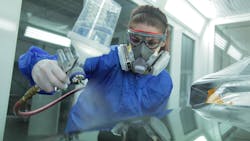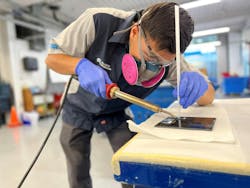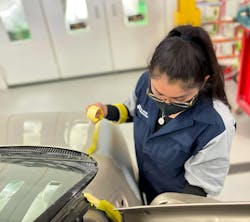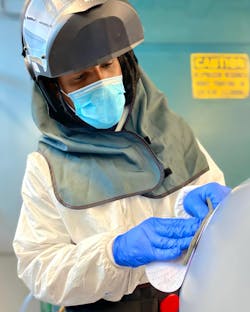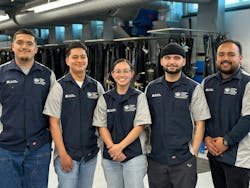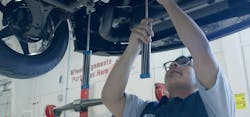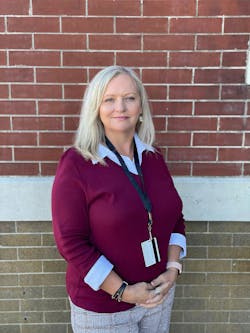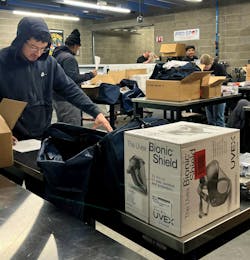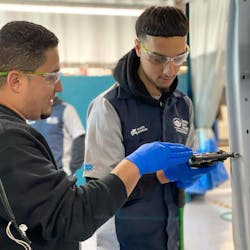Is the technician shortage simply a matter of being able to hire more staff? Or is there a greater problem of not keeping them? The Collision Engineering program is designed not only to attract and develop entry-level technicians but to enhance their retention and advancement. Formed by the Enterprise Mobility Foundation and Ranken Technical College and introduced in January 2021, the apprenticeship program bridges theory and practice. Through eight-week rotations, students can progress their learning first at college and then apply what they’ve just learned at a cooperating collision repair shop. After successful completion of the two-year program, students graduate with an associate’s degree.
“The Collision Engineering Program was developed to build a new generation of highly motivated, passionate, skilled collision repair technologists for the industry,” said Mary Mahoney, vice president of Enterprise Mobility’s replacement and leisure division, during a November Collision Industry Conference (CIC) presentation. “It’s education and industry working together in a collaborative partnership.”
The concept had first been proven at Ranken Technical College in St. Louis, Missouri. The Enterprise Mobility Foundation joined John Helterbrand, department chair of Ranken’s Automotive Collision Repair program, to duplicate its successes to other colleges across the country, which number seven as of this writing and boast a 100% industry-placement rate.
The Genesis of the Program
Like many “overnight successes,” it has taken time and support for the Collision Engineering program to grow to its current state. About a year after becoming department chair at Ranken, Helterbrand began the transition to the apprenticeship model in 2014 to attack two issues he was facing at the time: low enrollment and industry-retention.
“It was really kind of depressing. I had students who were amazing students; they were good at everything, including communication and hands-on skills,” says Helterbrand, Collision Engineeering national program director. “Maybe they didn’t get the best grades, but they were really good people. And you find out they were just eaten up and spit out. Most of them were out of the industry within six months of graduation. They may have done something with cars, but not in collision.”
He began talking to students and employers to see if he could help solve the problem. He discovered the employers often had the impression that recent graduates, proud of their newly learned skills, felt “entitled,” and they often didn’t know how to accept them into their culture. That led to the new hires walking away from not only that shop but the entire industry.
Helterbrand credits Ranken’s president at the time, Stan Shoun, with the genesis of the project.
“He was always looking for innovation and looking to bring attention to Ranken that really showed we were a very proactive college that was willing to help industry.”
So, they started examining programs that were successful in implementing mentorships and internships.
“Apprenticeships really hit on all the problems. You’re introducing a student at his or her earliest time not knowing a whole lot to [a shop owner or operator] who was taking a chance. It was building a community within the shop and building a new culture for the future.”
As Ranken is a nonprofit, private college, Helterbrand says the wheels of progress moved more rapidly than if he were trying to make changes at a community college.
The connections brought to the table by Ranken’s advisory board enabled the new program’s success, bolstered by Shoun, who empowered Helterbrand to get the program off the ground.
“He was always asking, ‘How are we doing?’ ‘What do you need?’ ‘What can I do for you?’”
Breaking Down the Silos
For his new Ranken program structure, Helterbrand shifted the paradigm of how curriculum was delivered. The traditional “silo system” of nonstructural, structural, collision mechanical, and then refinishing needed to adapt to fit the eight-week blocks of instruction and eight weeks of being a productive technician at the apprenticeship shop.
”If you look at the apprenticeship programs of the OEMs, they start at a very basic spot, from thinking about information-gathering, safety, all the way up to the most advanced technologies toward the end. But they also have to be able to teach a student a trade, a small bit of their trade, to be successful in those first eight weeks. We didn't have any of that.”
Mechanical automotive apprenticeships have a logical spot where they can start an apprentice before progressing to the next level, Helterbrand points out.
“We don’t have lube racks. We have places where you clean cars, and that’s usually where a good student gets lost, right?”
In contrast to a “binge-and-purge” style of learning conducive to a student learning information well enough to pass a test and then forgetting much of what he or she learned, skills-training is best done in smaller chunks, Helterbrand noted.
“If you had somebody who started off in our industry in refinishing, they would go from the basics of refinishing to the mastery of matching and blending a tri-coat color. Well, by the time they got to their last semester, they had never touched refinishing again. Now they couldn't even use the mixing machine; they didn't know the ratios for primer.”
Walking Before They Run
Students begin their first semester learning about personal protective equipment (PPE) and the basics of refinishing, such as understanding technical data sheets and determining what grit of sandpaper to use for which operations.
“We really want our students to be able to say they've touched each one of those components within the time they're in class.”
For the second eight-week rotation, many shop operators had told Helterbrand they’d be comfortable letting the apprentice prime. So, that’s the next stage in education.
“Then it’s ‘mixology’: understanding mixability, understanding the information on the scales, and then going into priming. They wouldn’t let him paint something – maybe a little cut-in, but they wouldn’t let him do anything substantial.”
So, the following semester continues to build on that knowledge and covers base coat and clearcoat application. Buffing, a task often viewed as tedious and given to the least tenured technician, is not a task an apprentice with only eight weeks of industry training should attempt, given the risk of causing redos, Helterbrand says, so it’s taught later in the course.
“For me, I always looked at it as after you’ve been trained on painting is a better time for you to start to sand finish down and apply some kind of material that’s going to remove finish depth.”
Helterbrand says although curriculum is not typically presented in this fashion, the modularity of I-CAR curriculum was conducive to the new structure.
Duplicating Success Nationwide
The first group at Ranken launched in 2018 and was an immediate success. About a year later, Enterprise representatives visited Ranken.
“Our president was very good friends with Enterprise; they did a lot of good things together. They’re great supporters of the college. I didn't realize the technician shortage had such a global impact. I knew about it, but I was concerned about Saint Louis.”
Enterprise took a keen interest. More meetings followed.
“One thing let to another, and the next thing I know, the boss is asking, ‘So, what do you think about a nationwide program?’”
Helterbrand started gathering momentum in May 2019 in talks with prospective schools. But bringing Ranken’s success to other programs across the country was not like opening a franchise restaurant such as McDonald’s, where Ranken’s program would be simply duplicated there.
“It was really getting people to understand a rotational education, that you can do that and how it's sustainable,” he says. “The biggest convincing we had to do was to break down the nonstructural, the structural, and the refinishing. The students need to taste a little of that every semester so they don't forget it and they can actually build upon it.”
With the new name of Collision Engineering, the pilot program rolled out in 2021.
“I think it really sets a standard to the next level. And the whole idea is the next level in the technician, the next level in high school education, the next level of college education. I think it also means pathways, because no engineer goes into engineering school without a good pathway of how to get there.”
Each of the schools develops its own advisory council to help guide the program, which ensures the training models are what the industry is looking for and is keeping pace with vehicle technology.
Education is Changing
The COVID-19 pandemic forced industry to be receptive to new delivery methods for training, Helterbrand says.
“Education's changing quickly. People may not see it because they're in the weeds at their college. But if you step away like I have for four years…Oh, my God. It’s a big-time change and it’s going to take over. If you look at what a lot in the background is going on, all these schools are wanting internships; they want apprenticeship programs. They want more involvement in their industry to be part of what they're doing. There are people who are putting a lot of money behind this to make this happen.”
He set out to meet with other college program leads and instructors. Not all understood Helterbrand’s intent with the program, fearing it would require “putting a Ranken in here” instead of giving the other colleges the tools and coaching they need to offer a similar program. But it resonated with those who were looking for such a program but didn’t know where to turn.
“We learned there are a lot of instructors out there who have a passion just like me. We believe we can do better for the student. If you’ve got a big enough belief system in that instructor, then good things happen, and that's how we got started; it was a belief that we could make something happen, and we did. And now, four years into this, it continues to grow. We’ve spoken to schools and employers from overseas here and everywhere. It's about people doing the right things in their community, and most of these people already knew what they needed: They needed some support. They needed people who thought like them.”
Although he’d worked with Enterprise on a number of projects over the years at Ranken, he was pleased to learn how much it supports sustaining the community.
“And what we're trying to do is sustain our industry within the community,” he says. “We rely on them in so many ways. To have them on board helped us get other grants, such as through ECMC [Foundation], Ford Motor Company, and others.”
The program boasts a total of 18 industry partners as of this writing.
Coordinating with Industry
Collision Engineering National Workforce Development Director Shelly Jones says successful implementation requires understanding other schools’ needs.
“We’ll set up meetings and we'll help the college speak to their community If they need that,” she says. “We identify what their needs and challenges are, and then we develop a plan to get them where they want to go. If the college has the passion to be a partner and to incorporate this apprenticeship and internship, then we are there to make sure that whatever their needs are for their situation, that's what we're going to address and get them where they need to be.”
The program is available and adaptable to any shop owner or operator, Jones says.
“Anybody who wants to get involved and be a part of this journey, we want to talk with them. Any shop can be a good fit for this. I think this is a great opportunity to build a pipeline. The shop just has to have that openness and willingness to learn something different if they haven't participated in an apprenticeship or an internship program before.”
To be successful, she says, the partnership between the shop and the college they work with is essential, including maintaining communication.
“And everything else will fall in line.”
Tuition Assistance, Paid Apprenticeship, Tool Kits, and Certifications
There is no cost for the Collision Engineering Program to either the shop or the college. The program does require the participating shop to pay apprentices the area minimum wage or higher. For each successfully complete work rotation during their first year in the program, students receive a $500 stipend, up to a total of $1,500. Students also receive a starter tool kit before their first work rotation at no cost. Collision Engineering instructors and students have designed the kit to include all tools needed for their apprenticeship, and upon completion, the kits are the students’ to keep. They also earn ASE certifications in two years that otherwise typically take an entry-level technician six years.
‘Helping Make Technicians Great and Employers Greater’
Helterbrand, who says he entered the collision repair industry in 1985 as a “dust bunny bodyman” and experienced the name change to “technician” as professionalism was being stressed and outside training such as I-CAR became prevalent, started teaching night school at Ranken 30 years ago before joining the staff full-time 19 years ago.
“I just got in this business to help students become great technicians,” he says. “But now, our team here is working so hard to make not just the students great, but the employers greater. These students of tomorrow are different students, not bad. You have to understand how they got there. You’ve got to meet them where they are, and if you don't understand that, you're probably not meeting your customers where they are, either.”
Increasing retention is a focus of the program, Jones says.
“Whether they're already employed as an entry-level employee at a collision shop, they’re upskilling, or they come off the street, they have chosen this as a career. We need to give them the best possible entry into this career to stick with it and make a long career out of it.”
That means providing a welcoming shop culture and a robust hands-on experience being taught the proper techniques and equipment, she says.
“We’re always thinking about the student in what we do. You have to put your empathetic hat on for all the people who are involved. And John talks about it all the time, meeting them where they are and giving them the tools to be successful. We really do step in to assist and guide to make sure they have those tools. And we see the success stories and you see that the colleges are proud of it. We're proud of it. The employers are proud of it. The momentum is growing, and it's just a lot of fun to be part of this.”
For more information, go to www.beacollisionengineer.com.
About the Author
Jay Sicht
Editor-in-Chief, FenderBender and ABRN
Jay Sicht is editor-in-chief of FenderBender and ABRN. He has worked in the automotive aftermarket for more than 29 years, including in a number of sales and technical support roles in paint/parts distribution and service/repair. He has a bachelor's degree in journalism from the University of Central Missouri with a minor in aviation, and as a writer and editor, he has covered all segments of the automotive aftermarket for more than 20 of those years, including formerly serving as editor-in-chief of Motor Age and Aftermarket Business World. Connect with him on LinkedIn.
Don't miss Jay's next article or podcast. Sign up for FenderBender Today's Collision Repair News and ABRN eNews here.
